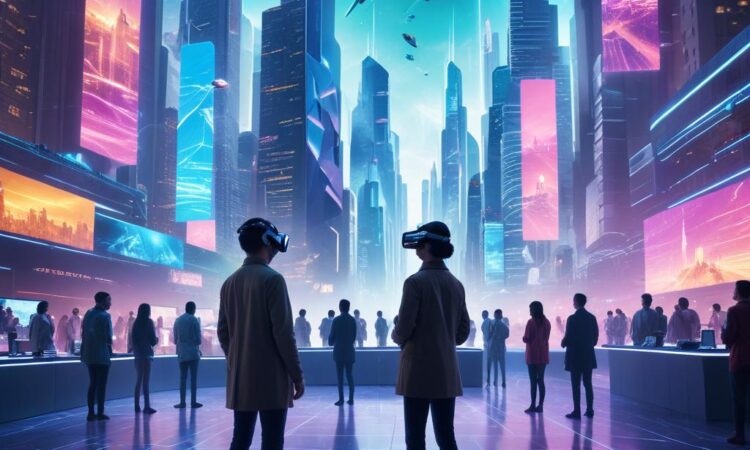The Future of Cinematic Storytelling
Filmmakers are constantly exploring new forms of storytelling, experimenting with technology, and pushing the boundaries of narrative and visual expression. The evolution of cinema is an ongoing process, driven by innovation and a desire to captivate audiences with fresh perspectives and immersive experiences. This essay delves into the exciting future of cinematic storytelling, exploring emerging trends, technological advancements, and the evolving relationship between filmmakers and their audiences.
The Rise of Interactive and Immersive Storytelling
Traditionally, cinema has been a passive experience, with viewers seated in darkened theaters, absorbing narratives projected onto a screen. However, the digital age has ushered in a new era of interactive and immersive storytelling, blurring the lines between audience and participant. Virtual reality (VR) and augmented reality (AR) technologies are transforming cinematic experiences, offering viewers the opportunity to step into virtual worlds and engage with narratives in unprecedented ways.
VR films, for instance, allow viewers to physically move through virtual environments, interacting with characters and objects in a more tangible manner. This immersive format has the potential to revolutionize genres such as horror, adventure, and historical dramas, enabling viewers to experience events firsthand. Imagine exploring ancient Rome with gladiators, or confronting a terrifying monster in a haunted forest, all within the confines of a VR headset.
AR, on the other hand, overlays digital content onto the real world, blurring the boundaries between reality and fiction. This technology can create interactive experiences where viewers interact with virtual objects and characters within their physical surroundings. Imagine walking down the street and encountering a talking dragon, or participating in a historical reenactment where virtual characters blend seamlessly with real-life actors.
The Power of Artificial Intelligence in Storytelling
Artificial intelligence (AI) is poised to play a significant role in shaping the future of cinematic storytelling. AI algorithms can analyze vast datasets of films, scripts, and audience preferences to generate insights that can inform creative decisions. For instance, AI can assist filmmakers in developing compelling characters, crafting engaging plots, and predicting audience responses.
One of the most intriguing applications of AI in storytelling is the creation of synthetic characters. AI-powered tools can generate lifelike digital avatars that can interact with actors and deliver realistic dialogue. This technology has the potential to create more diverse and inclusive casts, enabling filmmakers to explore complex narratives with characters that reflect the richness of human experience.
However, the use of AI in storytelling raises ethical considerations. There are concerns about the potential for AI to create biased or stereotypical narratives, or to displace human artists altogether. It is crucial to ensure that AI is used responsibly and ethically, fostering creative expression while upholding human values.
The Evolution of Visual Effects and Animation
Visual effects (VFX) and animation have always played a vital role in cinema, transporting audiences to fantastical worlds and creating captivating visual experiences. However, the technology behind these mediums is constantly evolving, pushing the boundaries of what is possible on screen.
Advances in computer graphics, motion capture, and real-time rendering have enabled filmmakers to create stunningly realistic CGI characters, environments, and special effects. From the photorealistic dinosaurs in \”Jurassic Park\” to the epic battles in \”Lord of the Rings,\” VFX has become an indispensable tool for storytelling.
Animation has also undergone a significant transformation. Traditional hand-drawn animation is still revered, but computer-generated animation has become increasingly sophisticated, offering new possibilities for storytelling. From the whimsical worlds of Pixar to the gritty realism of \”Spider-Man: Into the Spider-Verse,\” animated films are now capable of tackling complex themes and engaging audiences of all ages.
The Rise of Independent Filmmaking
The rise of independent filmmaking has democratized the film industry, empowering creators with limited resources to tell their stories. With advancements in technology, filmmaking equipment has become more affordable and accessible, allowing independent filmmakers to produce high-quality content on a smaller budget.
Streaming platforms such as Netflix, Amazon Prime Video, and Hulu have also provided a new avenue for independent filmmakers to reach global audiences. This shift in distribution has created a more diverse and inclusive filmmaking landscape, giving voice to filmmakers from all walks of life.
The Role of Technology in Audience Engagement
Technology is not only shaping the way films are made but also the way they are consumed. Social media platforms, streaming services, and interactive technologies are creating new avenues for audience engagement and discussion.
Filmmakers are increasingly using social media to connect with their audiences, sharing behind-the-scenes content, engaging in Q&A sessions, and fostering a sense of community. Streaming platforms are incorporating interactive features such as skippable intros, personalized recommendations, and live-streaming events, enhancing the viewing experience.
The Future is Collaborative and Inclusive
The future of cinematic storytelling is likely to be characterized by collaboration, inclusivity, and a blurring of traditional boundaries. Filmmakers will increasingly work together, harnessing the power of different technologies and perspectives to create more immersive and engaging experiences.
The industry is also embracing a more inclusive approach, representing diverse voices and stories on screen. This shift reflects the growing awareness of social and cultural issues, and the need for greater representation in media.
Conclusion
The future of cinematic storytelling is bright and full of possibilities. With emerging technologies, creative innovation, and a growing emphasis on inclusivity, filmmakers are poised to captivate audiences with new and exciting forms of narrative expression. As the boundaries between reality and fiction continue to blur, the possibilities for cinematic storytelling are truly limitless.

